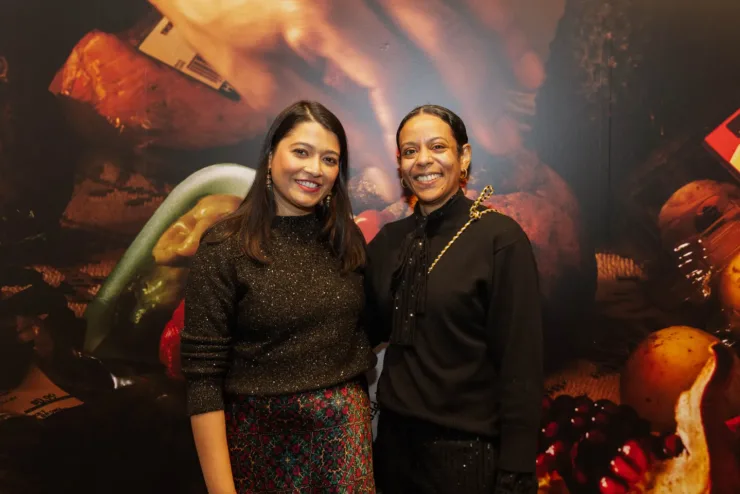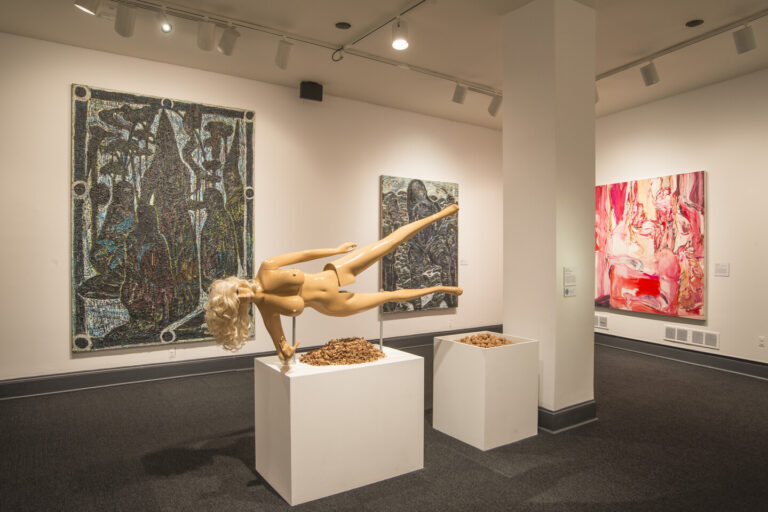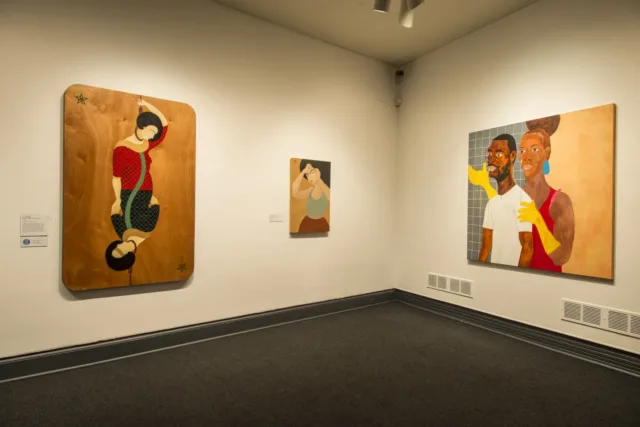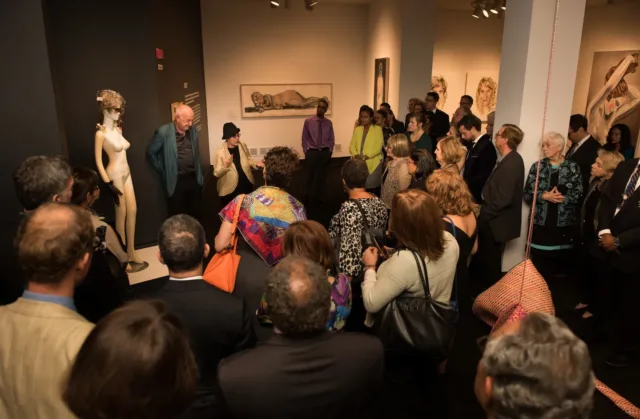Paintings and sculptural hybrids in NO MAN’S LAND demonstrate the expressive and technical range of contemporary women artists. With roots in 16 countries, the featured artists are generationally, aesthetically, and politically diverse. Collectively, they populate “no man’s land”: an open, liberated, and adaptable creative space. Our museum’s curators worked with the staff of the Rubell Family Collection to create a presentation that focuses on the traditional mediums of painting and sculpture as a way to highlight how women artists have pushed and redefined the boundaries of such categories.
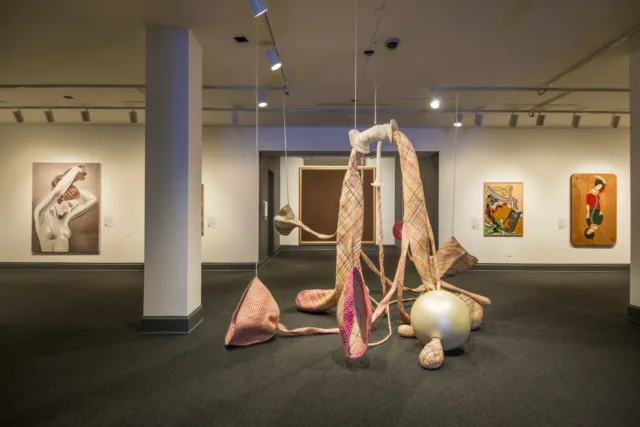
Installation view of NO MAN’S LAND, 2016; Photo by Lee Stalsworth
Contemporary artists explore the expressive potential of the female body. Some likenesses convey an individual’s psyche, while others signify broader ideas about culture, gender, and ethnicity. Through most of Western art history, male artists controlled the representation of the female body. During the feminist art movement in the 1960s and ’70s, women artists claimed ownership over visualization of the body. Today, some artists adapt art-historical motifs such as the odalisque, a reclining figure, by transforming its typically passive character. They also modify the traditions of portraiture, often shaping their imagery through sources such as mass media photography. Painters in NO MAN’S LAND depict women who appear mysterious, powerful, and resolute. Sculptors satirize unrealistic standards imposed on the female form.
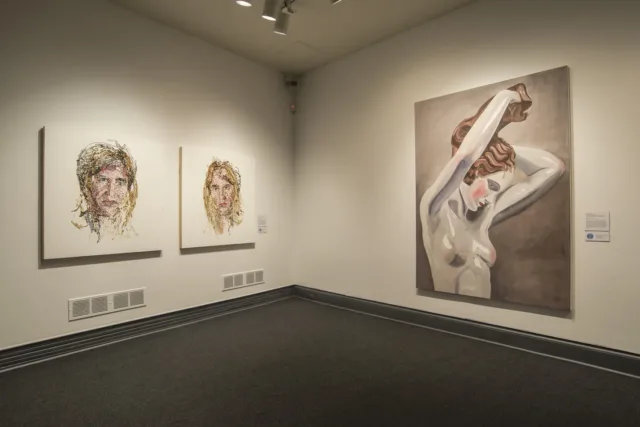
Installation view of NO MAN’S LAND, 2016; Photo by Lee Stalsworth
“Dancy modifies the clichéd role of the female nude as an erotic object. The artist notes, ‘I’m interested in sexiness as a channel for the presentation of multiple, splitting selves.’”
– Ginny Treanor, associate curator, NMWA
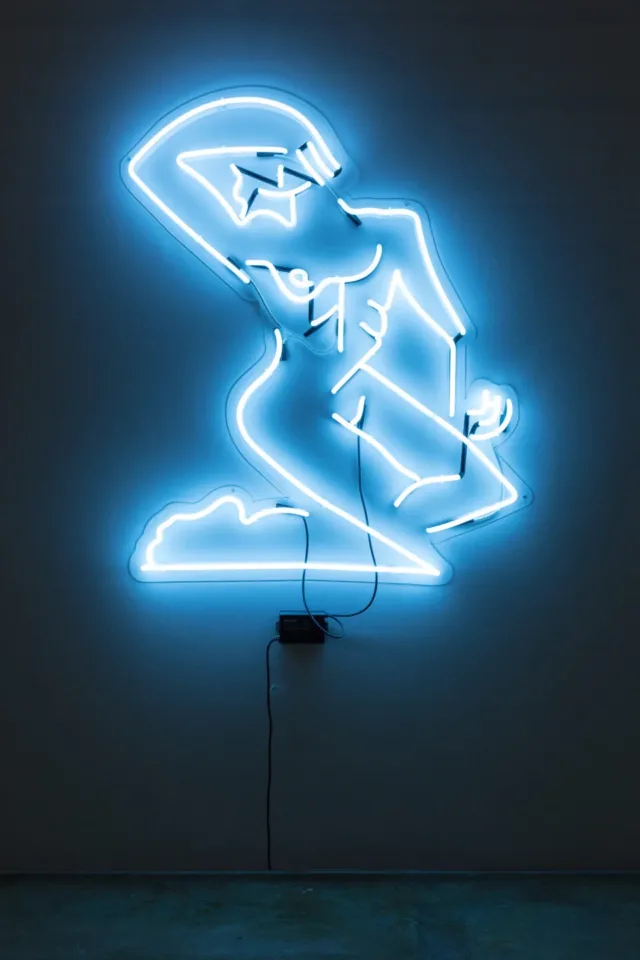
Mira Dancy, Street Ofelioa (neon blue), 2014; neon, 60 x 48 in.
“Nepomuceno’s biomorphic sculpture is dominated by spiral forms, alluding to naturally occurring spirals from DNA to galaxies.”
– Ginny Treanor, associate curator, NMWA
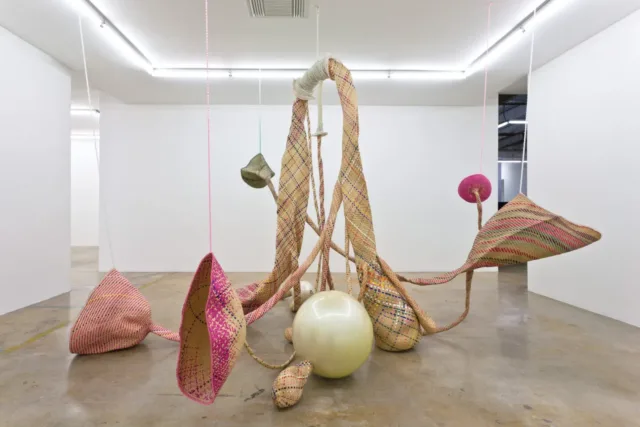
Maria Nepomuceno, Untitled, 2010; Braided straw, ropes, and beads, 173 x 157 x 137 in.
“In her series of sculptures formed from consumer products, Meckseper reflects on the subversive power behind commercialism and how the commercial zone sometimes becomes a political one. With its mirrored base, American Leg evokes the glamorous presentation of banal objects in retail spaces.”
– Ginny Treanor, associate curator, NMWA
Hear a poem selected by Josephine Meckseper to accompany this work
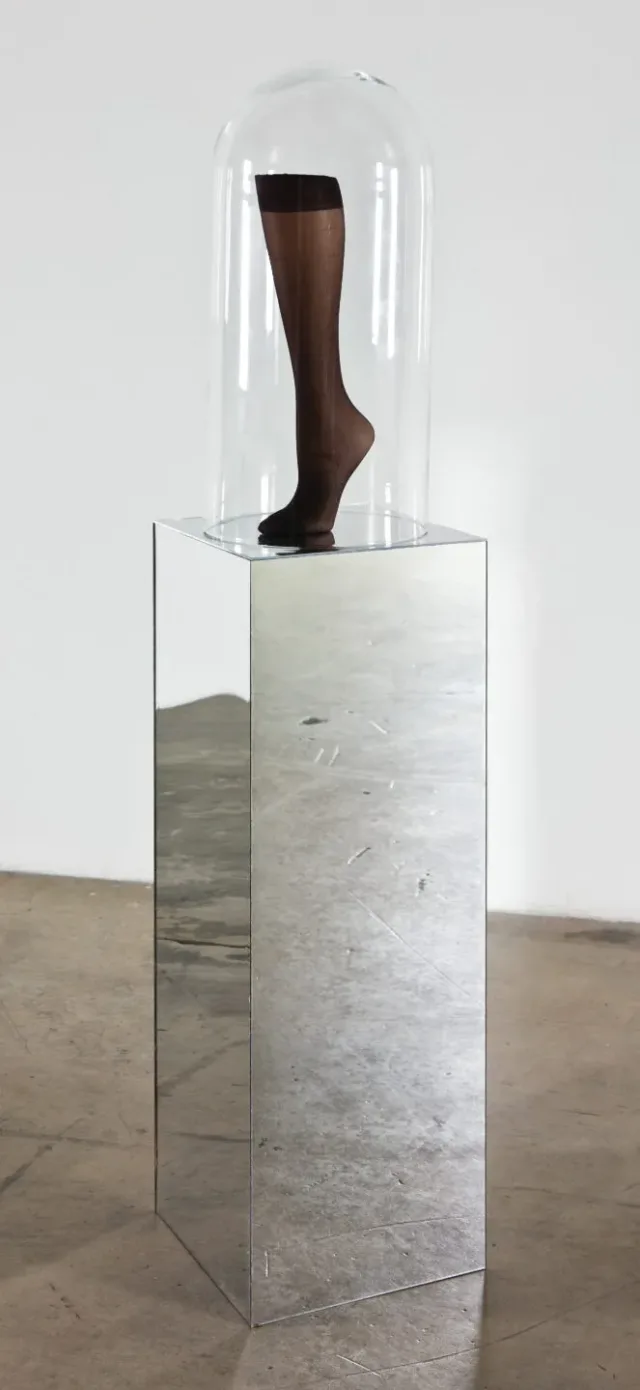
Josephine Meckseper, American Leg, 2010; Mannequin leg, hosiery, glass, and mirror, 24 x 11 ½ x 11 ½ in.
“The figures and expansive backgrounds in Takano’s paintings blend elements from manga (comic) illustration and nineteenth-century Japanese Ukiyo-e paintings and prints.”
– Ginny Treanor, associate curator, NMWA
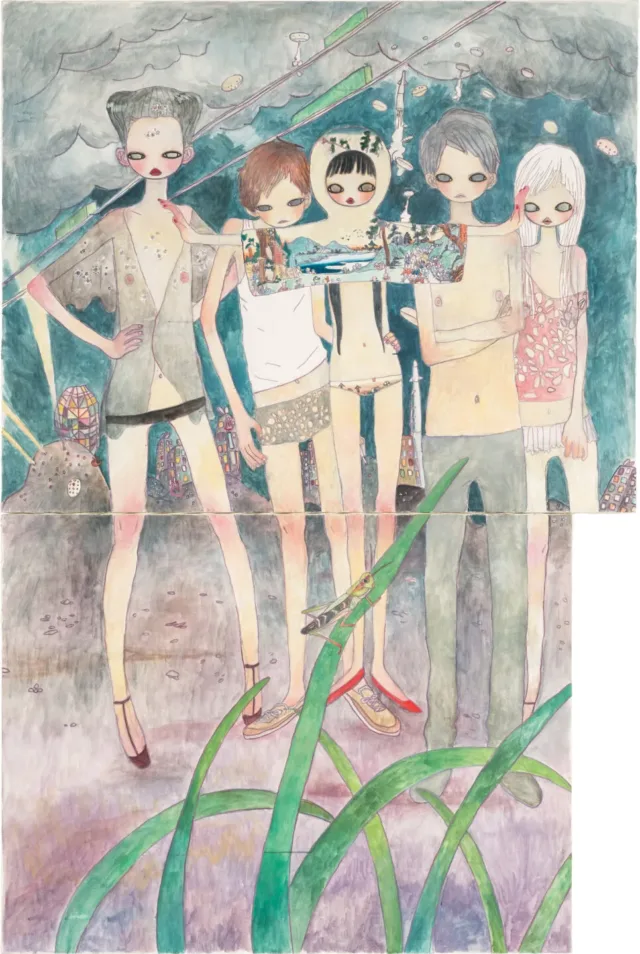
Aya Takano, On the Night of Departure, Black Hair Flows, 2003/2004; Acrylic on canvas, 108 x 63 ¼ in.
“My work tends to be very violent and it also deals with the element of displacement and more often than not, it is a figure of a woman…There is this linear narrative in each one of these works where, you know, one figure represents the past life in their homeland and the mirrored figure is a representation of the current, present life as an immigrant.”
– Hayv Kahraman, artist
Hear Hayv Kahraman discuss this work
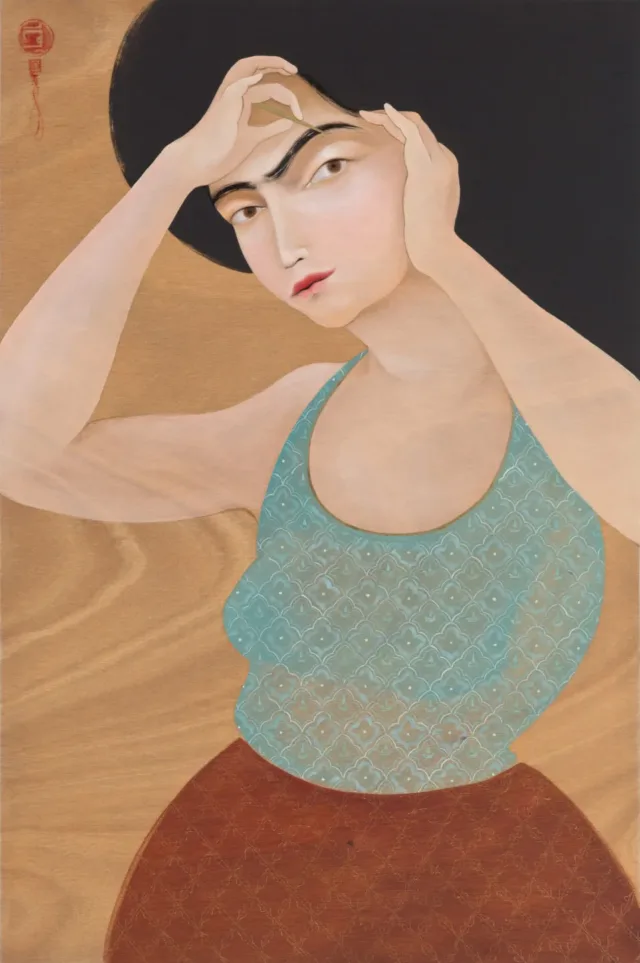
Hayv Kahraman, Prelude, 2011; Oil on panel, 36 x 24 in.
“Maybe it’s a critical statement about the attempt of women to alter their physical appearance.” – Don Rubell, collector
“Or maybe it’s the pressure that society puts on women to address the physical all the time.” – Mera Rubell, collector
Hear Don & Mera Rubell discuss Isa Genzken’s art
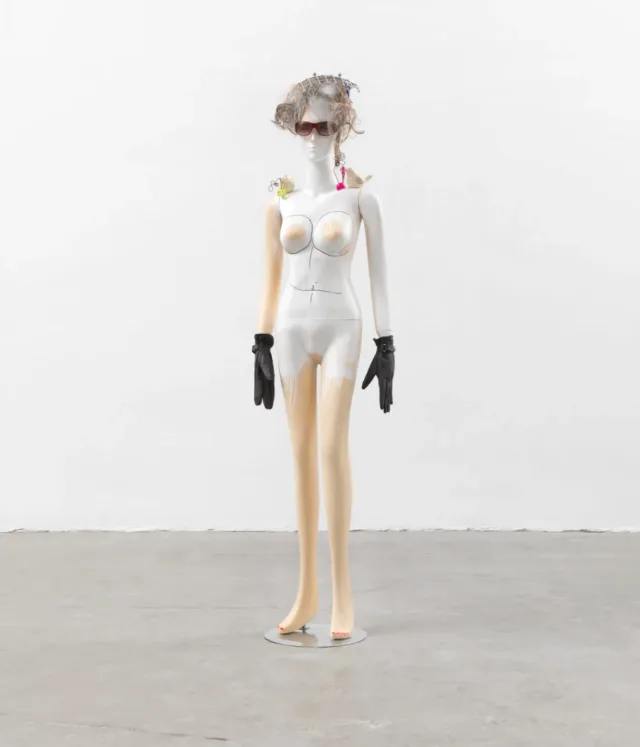
Isa Genzken, Schauspieler, 2013/2015; Mannequin, wig, glasses, lacquer, felt pen, leather gloves, ceramic figurines, metal, and acrylic glass, 72 ¼ x 18 ½ x 10 ½ in.
“Dumas derives many of her subjects from photographic images, clipped from disparate sources, including magazines and advertisements. She applies her subdued colors in broad washes that often bleed together.”
– Ginny Treanor, associate curator, NMWA
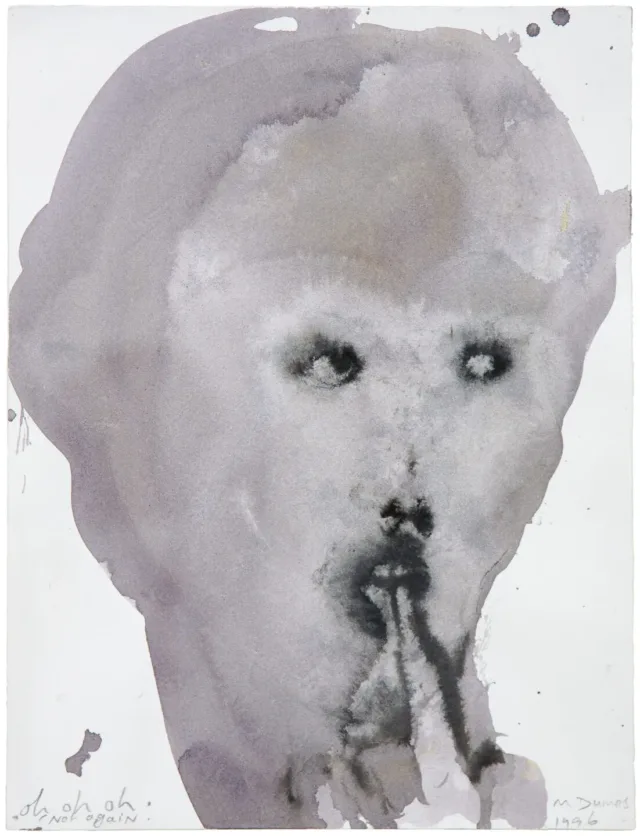
Marlene Dumas, Oh, Oh, Oh, Not Again, 1996/2001; Ink and metallic acrylic on paper, 13 ¼ x 10 in.
“This woman’s blue-hued face resembles a mask. The ambiguity of the setting as well as the action of the figure (is she covering or revealing her nudity?) add to the enigmatic quality of the work.”
– Ginny Treanor, associate curator, NMWA
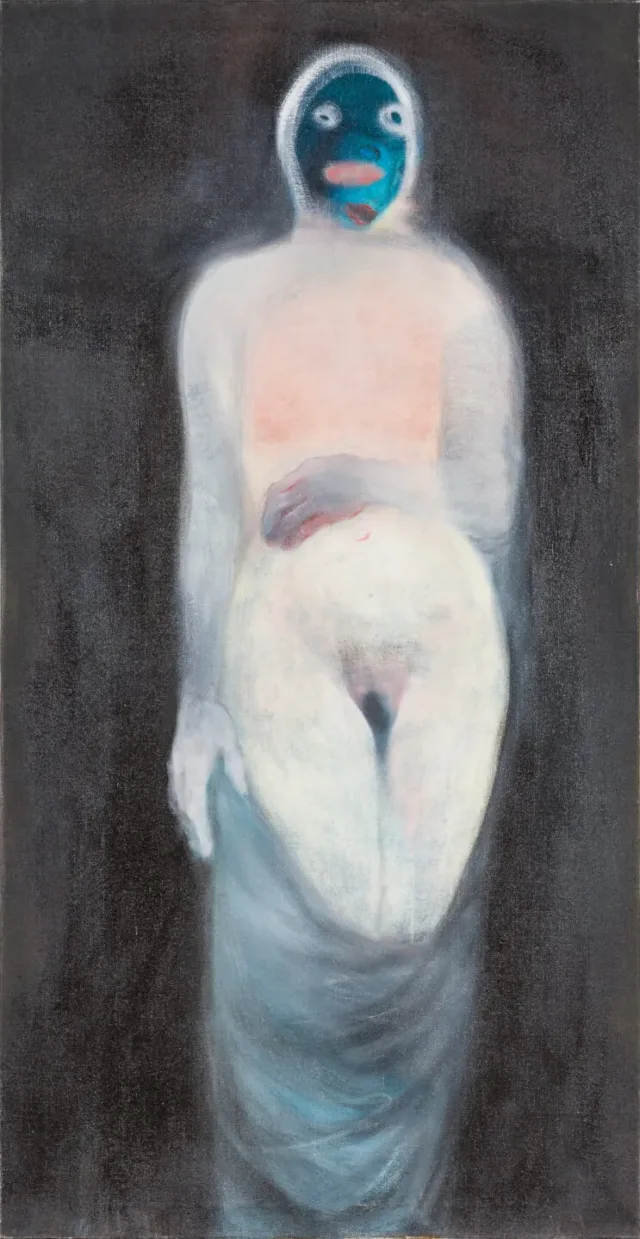
Miriam Cahn, Versehrt, 1998/2013; Oil on canvas, 67 x 34 ½ in.
“She is obsessed with the social portraits of our time, be it the Sex Pistols, be it her friends, be it pop figures.”
– Don Rubell, collector
Hear Don Rubell discuss Elizabeth Peyton’s art
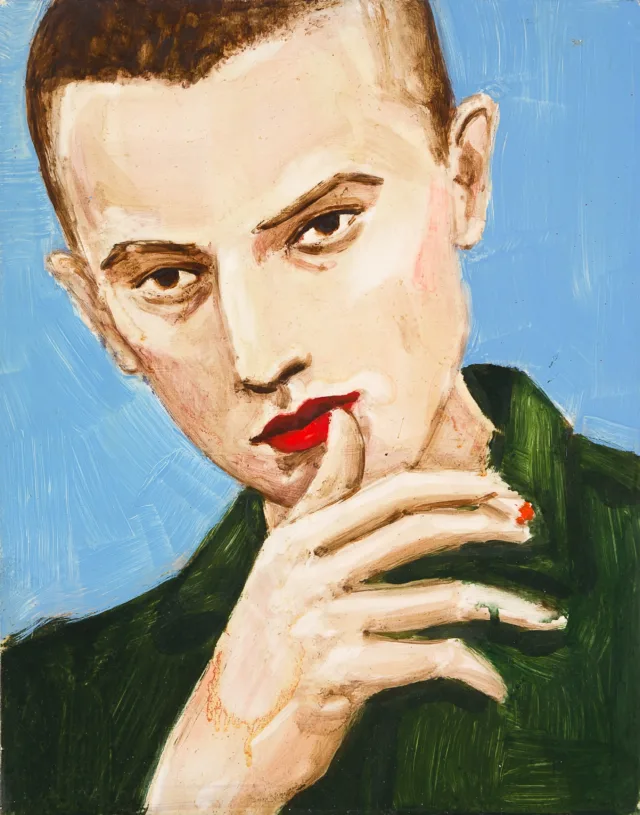
Elizabeth Payton, Burkhard Riemschneider, 1995/1997; Oil on board, 14 x 11 in.
“What she found in this merger [of the two portraits] was a new territory of identity, of maybe compromise, maybe psychological interactiveness.”
– Mera Rubell, collector
Hear Mera Rubell discuss Kaari Upson’s art
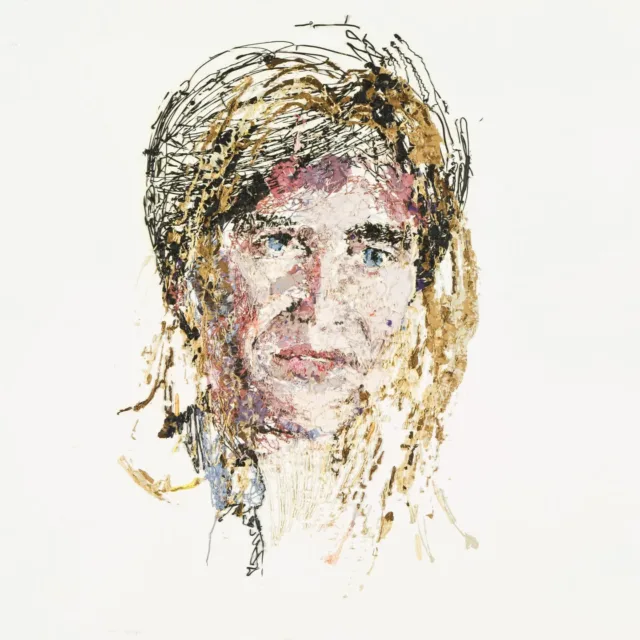
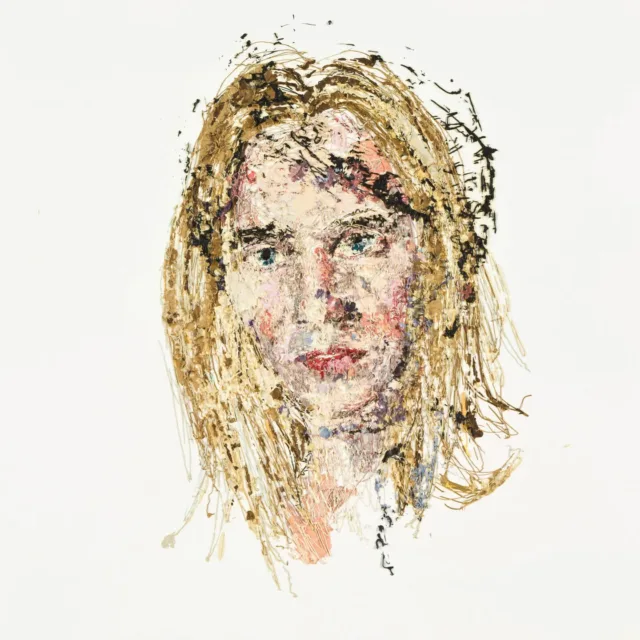
Kaari Upson, Kiss 8,2015; Oil on panel, 48 x 48 in. each
“Discarded auction catalogues I found became my primary muses for a while. I made a number of paintings based on porcelain figurines I saw in these catalogues…at first glance, these figurines seem like such mundane kitschy objects found on grandma’s mantle, but the longer I looked, the more perverse and sinister they seemed.”
– Amy Bessone, artist
Hear Amy Bessone discuss this work
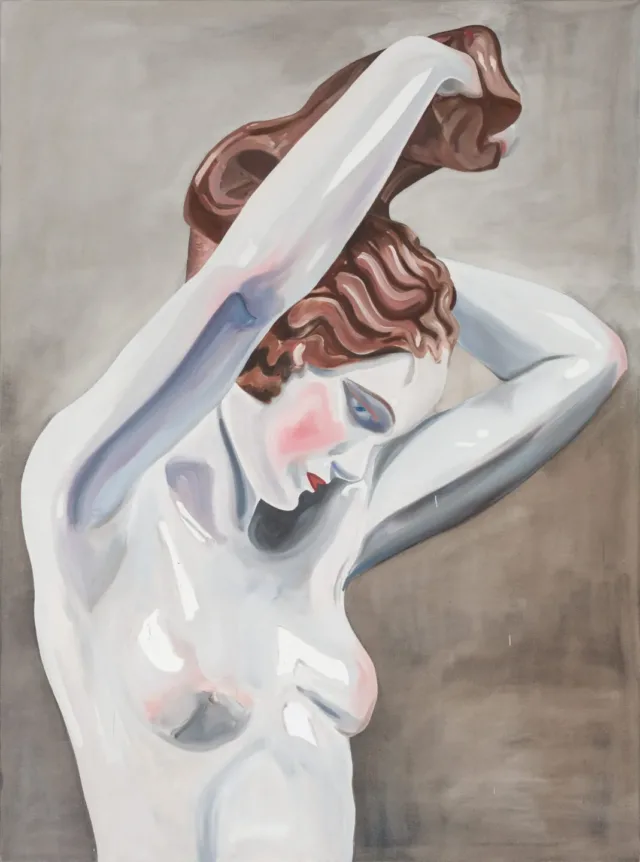
Amy Bessone, No. 329 (Edit), 2007; Oil on canvas, 86 x 64 in.
“All of my muses usually possess this particular gaze where they are inviting the viewer to look at them. The notion of looking at someone is to validate their existence. Maya is claiming her space.”
– Mickalene Thomas, artist
Hear Mickalene Thomas discuss this work
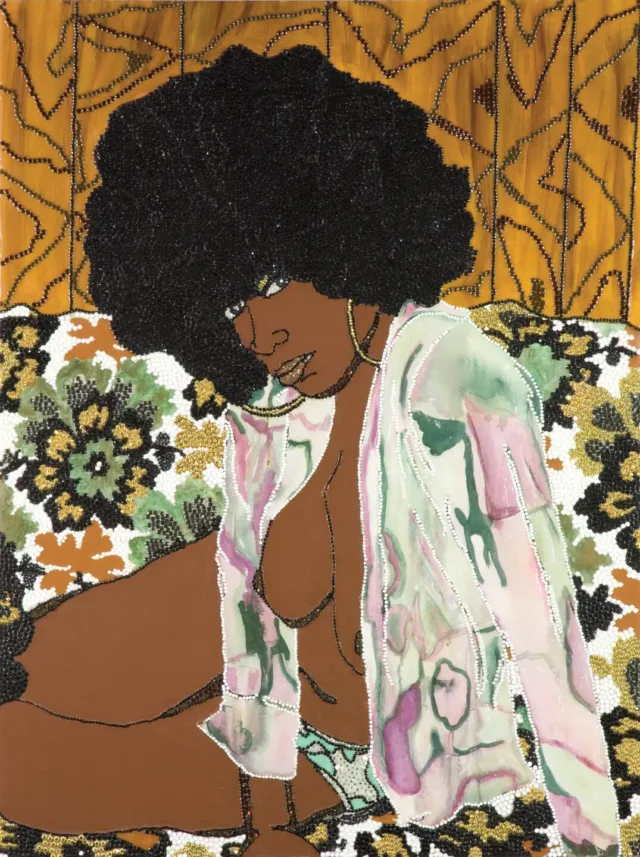
Mickalene Thomas, Whatever You Want, 2004/2005; Acrylic, rhinestones, and enamel on wood panel, 48 x 36 in.
“Blending watercolor with collaged photo clippings, Mutu builds biomorphic forms that sometimes coalesce into female figures.”
– Ginny Treanor, associate curator, NMWA

Wangechi Mutu, The Evolution of Mud Mama from Beginning to Start, 2008; Watercolor, gold leaf, and collage on paper, 19 ½ x 75 in. overall; 14 ¼ x 11 in. each.
“Abney’s images are mash-ups of her own thoughts and dreams, which are influenced by the daily barrage of media stories about race, politics, and celebrities.”
– Ginny Treanor, associate curator, NMWA

Nina Chanel Abney, Khaaliqua & Jeff, 2007; Acrylic on canvas, 61 x 63 ¾ in.
“Rozeal’s blending of Japanese Ukiyo-e–inspired figures and hip-hop aesthetics arises from her interest in the ganguro subculture in Japan. Hallmarks of ganguro style include elaborate hairstyles, long fingernails, and darkening of the skin, which participants associate with American rap culture.”
– Ginny Treanor, associate curator, NMWA
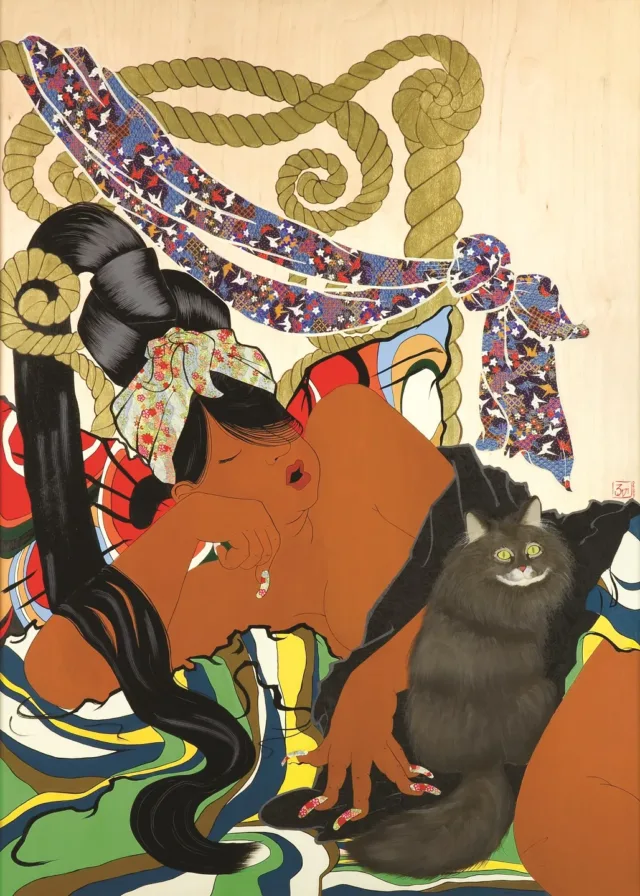
Rozeal, Sacrifice #2: It Has to Last (after Yoshitoshi’s “Drowsy: the appearance of a harlot of the Meiji era”), 2007; Enamel, acrylic, and paper on panel, 52 x 38 in.
“The nutcracker work came about after I saw this nutcracker online of Hillary Clinton where you put nuts between her legs and crack them. And I loved the idea of the act of cracking a nut being this kind of scary act of female power.”
– Jennifer Rubell, artist
Hear Jennifer Rubell discuss this work
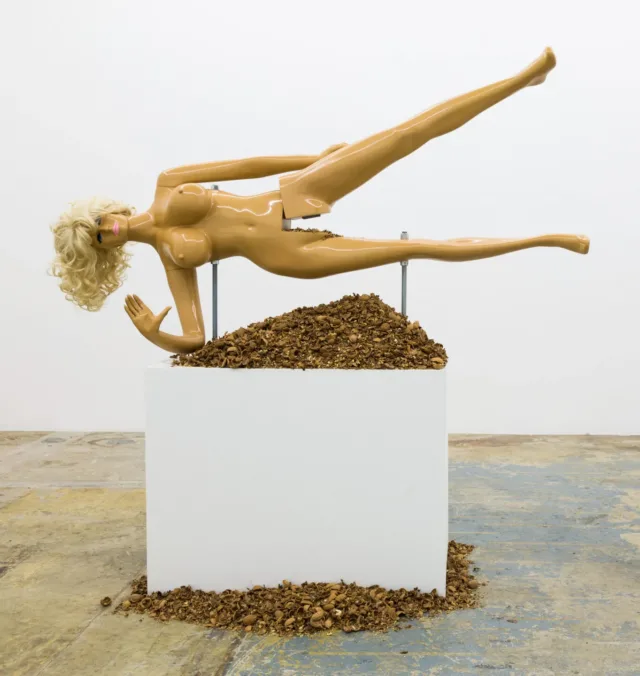
Jennifer Rubell, Lysa III, 2014; Fiberglass, resin, and steel, 72 x 62 x 24 in.
“We entered [her studio], like a windowless closet, there was this painting hanging on the wall. It was inconceivable that she could invent so much color and so much dynamic expression and so much imagination in this windowless, airless space.”
– Mera Rubell, collector
Hear Don & Mera Rubell discuss Dana Schutz’s art
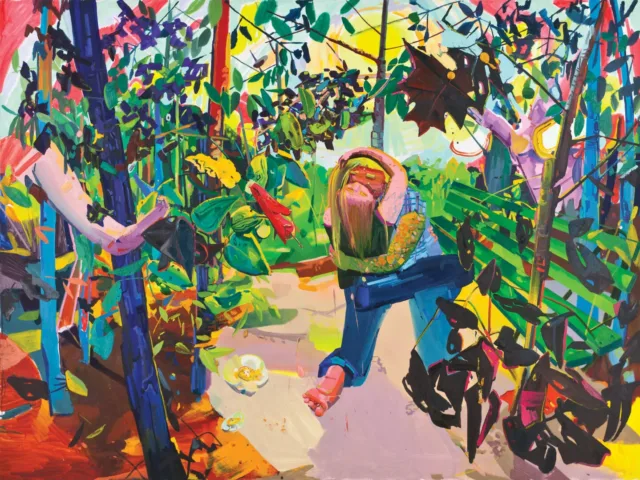
Dana Schutz, Lovers, 2003; Oil on canvas, 84 x 100 in.
“The image of a reclining figure seemingly haunted by hallucinatory forms was loosely based on a late 19th-century print of a male figure hypnotized by erotic imagery that seems to float in the space above him.”
– Cecily Brown, artist
Hear Cecily Brown discuss this work
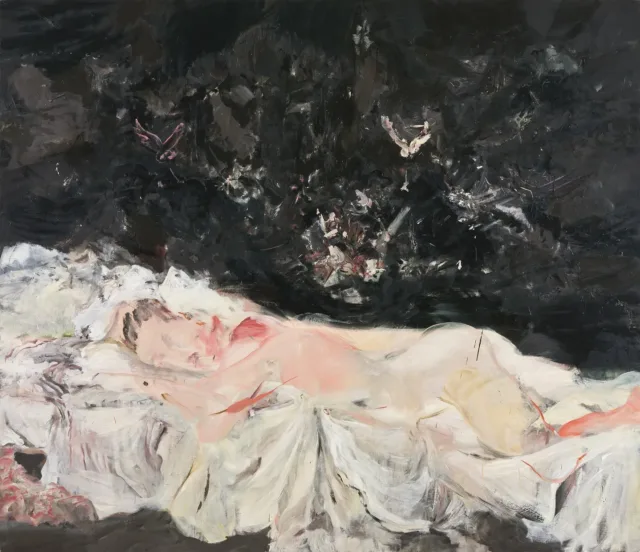
Cecily Brown, Black Painting 4, 2003/2004; Oil on linen, 75 x 90 in.
“I was intuitively looking at the dark authority of religion and the way that people relate religion and mysticism…I wanted to invoke a romantic image, the attraction of a figure that holds a group of followers spellbound.”
– Natasja Kensmil, artist
Hear Natasja Kensmil discuss this work
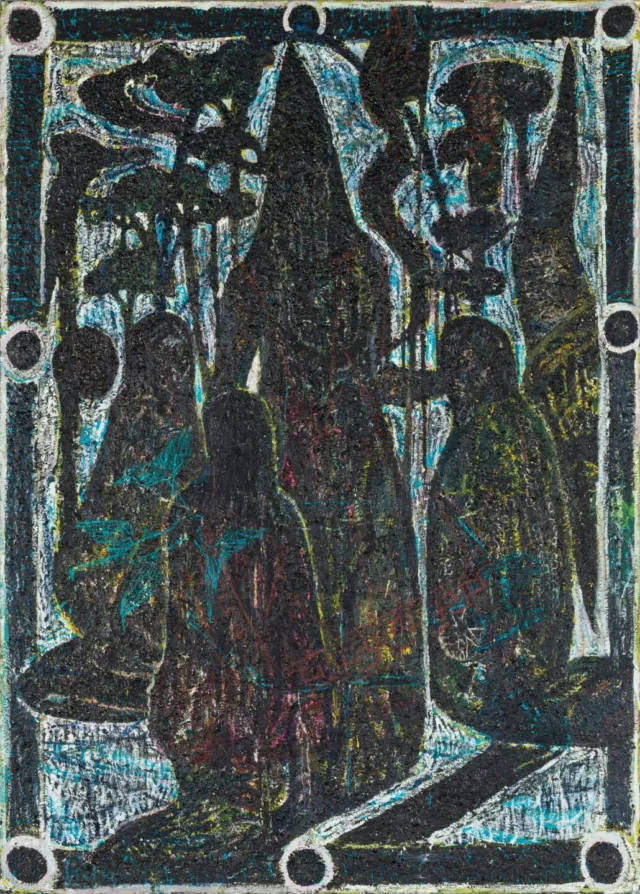
Natasja Kensmil, Desperate Land, 2004/2007; Oil on linen, 110 ¼ x 79 ¾ in.
“I finished this painting, titled St. Brigid’s Vision, soon after my mother’s death. It has the fleeting quality of a vision, a light shining in the darkness. I think it is the ordinariness of what she saw that moved me.”
—Celia Paul, artist
Hear Celia Paul discuss this work
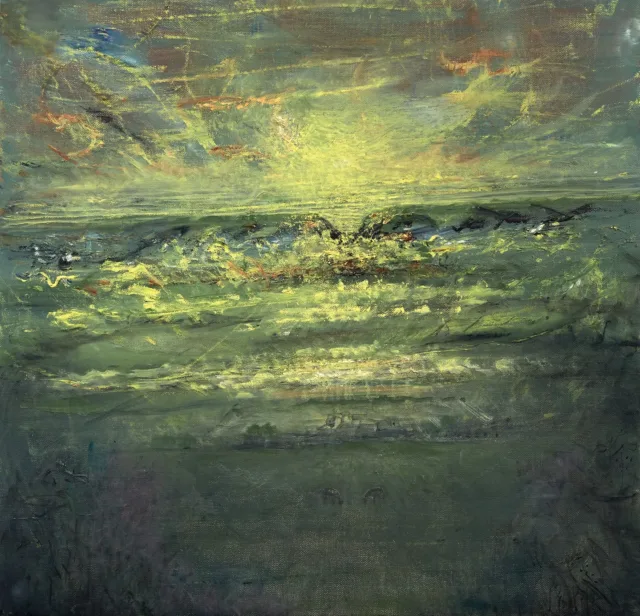
Celia Paul, St. Brigid’s Vision, 2014-2015; Oil on canvas, 40 x 42 in.
For artists in NO MAN’S LAND, the physical process of making is key to developing meaning, exploring intellectual conundrums, and conjuring psychological experiences. Labor-intensive processes and unusual materials are often associated with craft, a practice traditionally viewed as inferior to the fine arts. Artists in this exhibition eliminate hierarchies among mediums. They freely sample among the aesthetics and techniques of design, consumer products, and urban environments. Sculptors build with concrete, straw, flowers, and mannequins. Painters transform pigment into sculptural objects or approximate brushstrokes with wool and neon. Previously, the sensual appeal of “crafted” objects was believed to stimulate the senses more than it engaged the mind. Painter Li Shurui observes, “As the physical experience accumulates, something akin to faith begins to emerge within the overall process.”
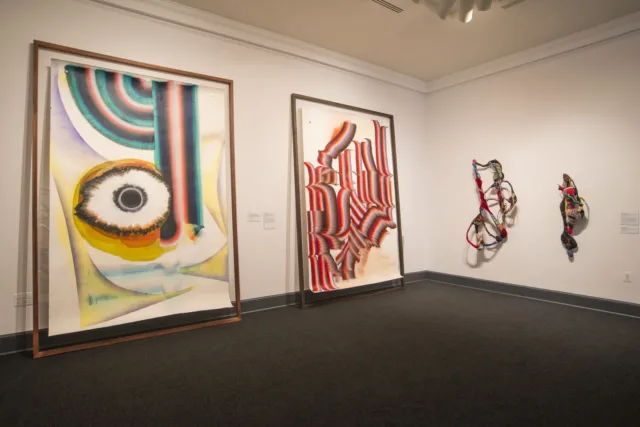
Installation view of NO MAN’S LAND, 2016; Photo by Lee Stalsworth
“I think it’s mind expanding for [children] to think, wow, I can make art with fried tempura flowers. Fried tempura flowers can be art. Anicka is always surprising us with the materials.”
– Mera Rubell, collector
Hear Mera Rubell discuss Anicka Yi’s art
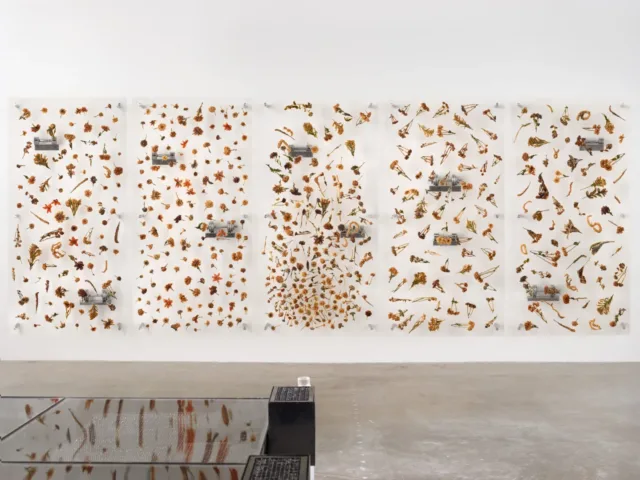
Anicka Yi, Life Serves Up The Occasional Pink Unicorn, 2013/2014; Tempura-fried flowers, resin, Plexiglas, stainless steel shelves, and chrome- plated dumbbells, 96 x 248 x 6 in.
“McClelland’s paintings express the emotional impact of sound and language. She says of her her early works, ‘The drawing had to do with what I was hearing. New York was full of human and mechanical sound, and that’s what I sought to reflect.’”
– Kathryn Wat, chief curator, NMWA
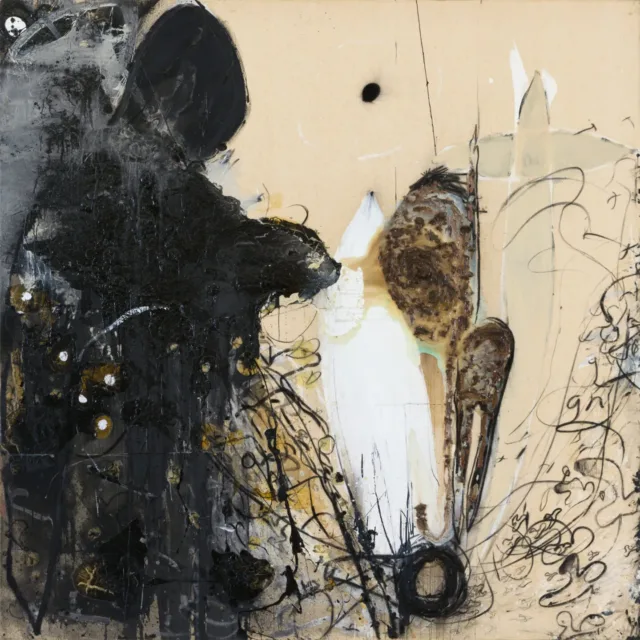
Suzanne McClelland, Right, 1991/1994; Acrylic, clay, gesso, and charcoal on canvas, 96 x 96 in.
“Molzan breaks down viewer’s conventional expectation of a painting as a flat rectangle hanging on a gallery wall by focusing instead on the elemental components of painting: wood stretcher bars, canvas, pigment, and handwork.”
– Kathryn Wat, chief curator, NMWA

Dianna Molzan, Untitled, 2010; Oil on canvas on fir, 55 x 36 in.
“You have to see this work from a distance, but then, get really, really close to this work and appreciate that every single dot represents the signature, the hand movement of the artist. Once you see those dots, no one else can make that dot, I mean, how can a dot be a signature, well it just is and look at the power and magic of this work.”
– Mera Rubell, collector
Hear Don & Mera Rubell discuss Jennifer Guidi’s art
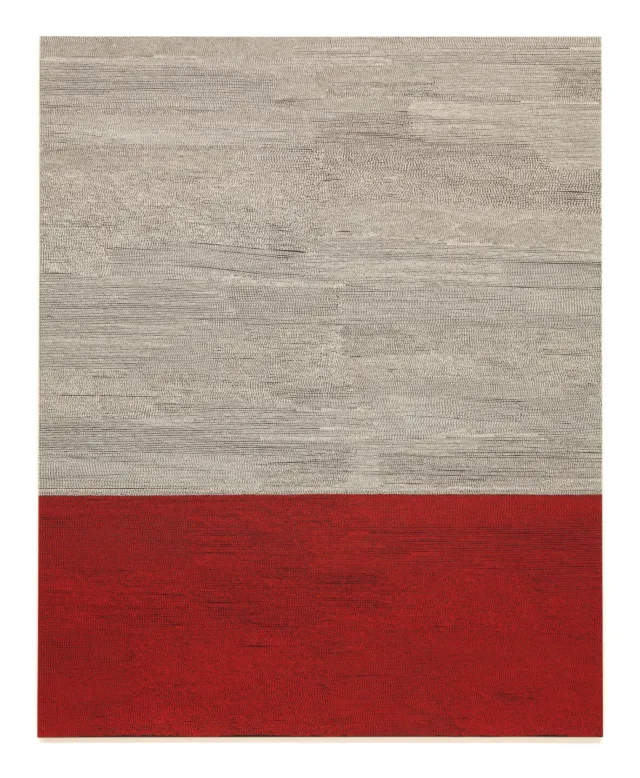
Jennifer Guidi, Untitled (TRF #3 Black, White and Red), 2015; Oil on linen, 92 x 74 in.
“The collection of these materials in Menagerie, and perhaps all of my works, form a sort of diary of where I have been, the experiences I have had, and the beauty I find in everyday things.”
– Shinique Smith, artist
Hear Shinique Smith discuss this work
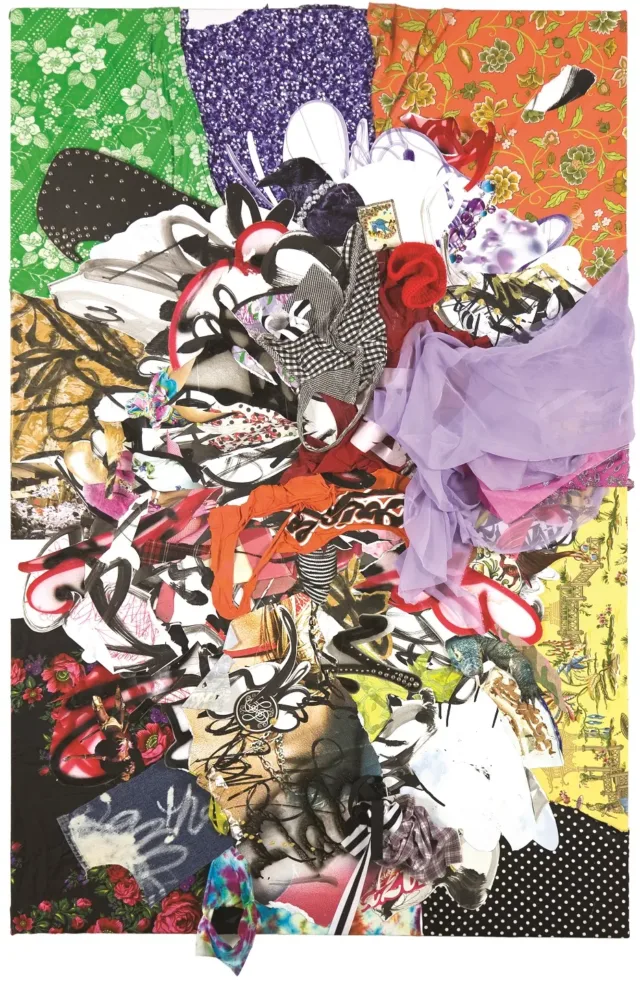
Shinique Smith, Menagerie, 2007; Mixed media on canvas, 72 x 48 in.
“In this work, she revises the conventional idea that canvas is a support for paint by stitching it into a container that appears to hold paint.”
– Kathryn Wat, chief curator, NMWA
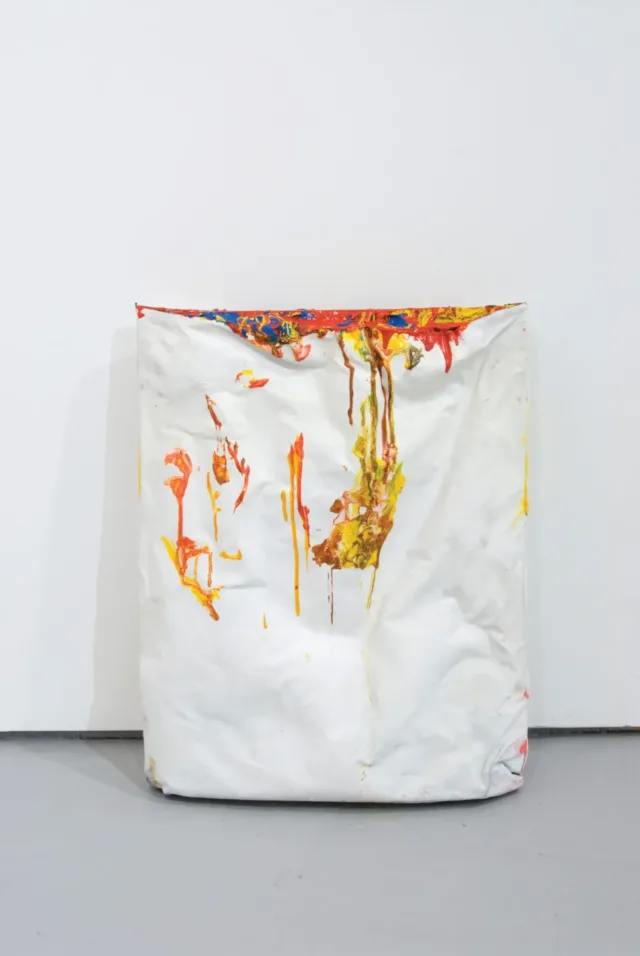
Analia Saban, Acrylic in Canvas, 2010; Acrylic in canvas bag, 21 x 16 ¼ x 4 in.
“In her large-scale sculptures, Pessoa combines elemental materials and abstract shapes to develop a range of organic associations and psychological moods.”
– Kathryn Wat, chief curator, NMWA
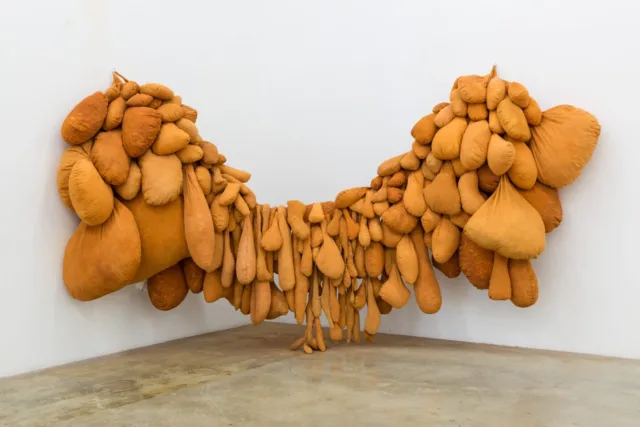
Solange Pessoa, Hammock, 1999-2003/2015; Fabric, earth, and sponges, 85 x 166 x 48 in.
“Trockel questions the assumed hierarchy of materials, which places painting at the top and craft at the bottom. ‘I tried to take wool, which was viewed as a woman’s material, out of that context and to rework it in a neutral process of production,’ she recalls.”
– Kathryn Wat, chief curator, NMWA
Hear Don & Mera Rubell discuss Rosemarie Trockel’s art
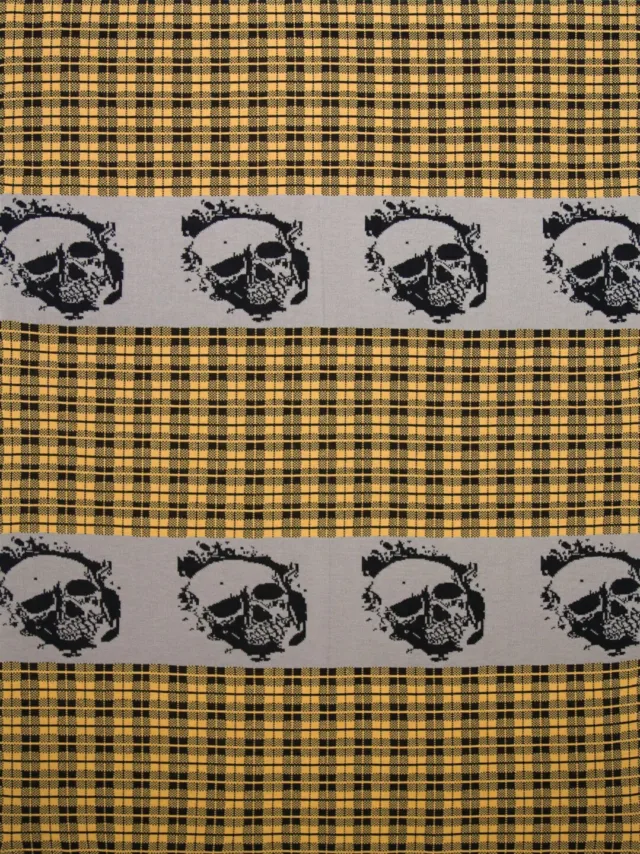
Rosemarie Trockel, Untitled, 1990/2006; Wool, 78 ½ x 59 in.
“Oh Baby #1 and #2 is a diptych…comprised of modernist stripes evoking a tightly covered body part and a wink to Op Art, pop culture, and the appropriated art-making concepts of the ’80s.”
– Karin Davie, artist
Hear Karin Davie discuss this work
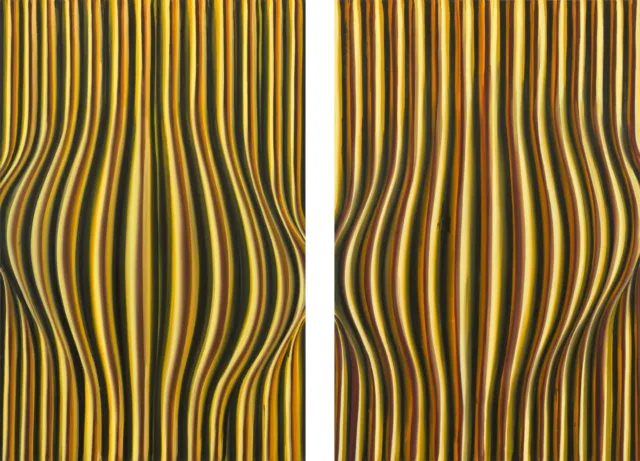
Karin Davie, Oh Baby #1 and #2 (from the “Sidewalk” series), 1992; Oil on canvas, 90 x 60 in. each
“It is kind of a Zen experience. I think for her it is Zen, and for the viewer it becomes that. There is this comfort in the repetition bringing a certain kind of order to her universe and may be an order to our universe.”
– Mera Rubell, collector
Hear Don & Mera Rubell discuss Yayoi Kusama’s art
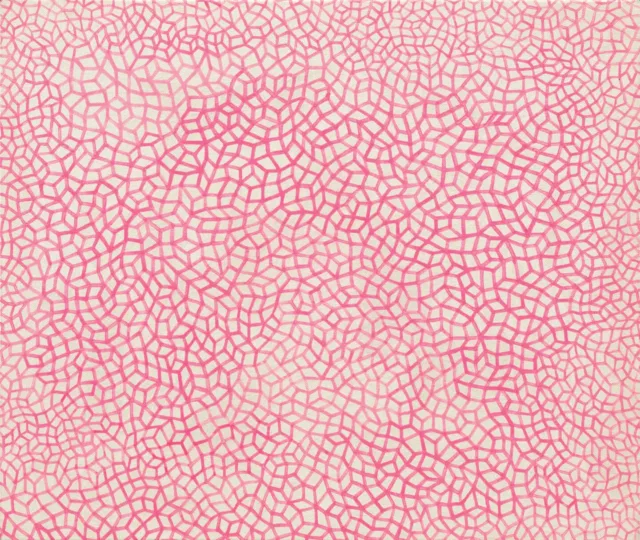
Yayoi Kusama, INFINITY NETS (H10), 2000/2009; Acrylic on canvas, 15 x 18 in.
“Brätsch’s arcing swaths of color echo the sweeping motion of her hand: ‘The brushstroke becomes a stand-in for its physical process,’ she says.”
– Kathryn Wat, chief curator, NMWA
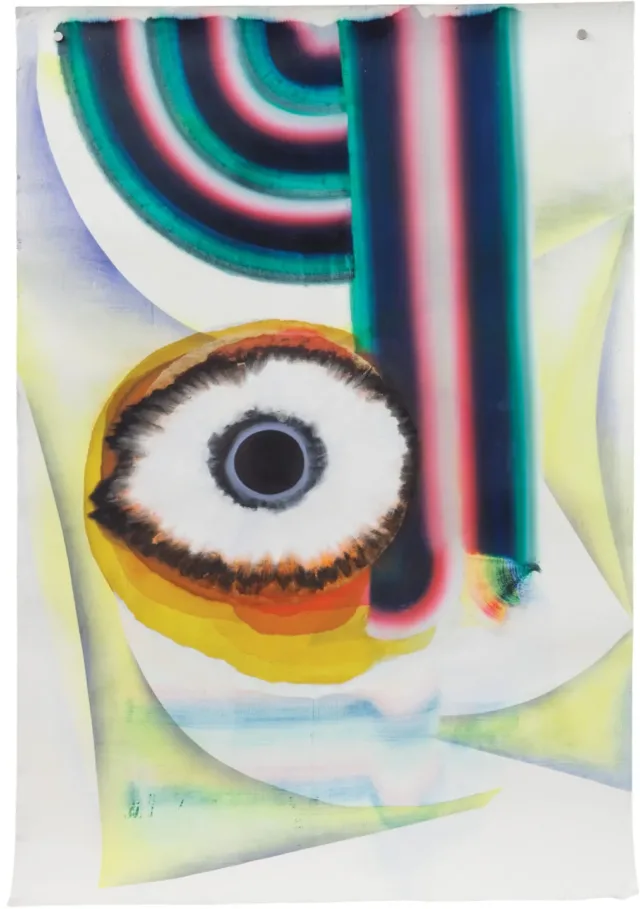
Kerstin Brätsch, When You See Me Again It Won’t Be Me (from “Broadwaybratsch/Corporate Abstraction” series), 2010; Oil on paper, 110 x 72 in.
“Weatherford applied paint with large brushes and sponges to achieve the saturated blue-blacks at the center of the canvas and soft oranges and pinks at the perimeter, suggesting a late evening atmosphere. The tube of neon reflects the feeling of New York City.”
– Kathryn Wat, chief curator, NMWA

Mary Weatherford, past Sunset, 2015; Flashe and neon on linen, 112 x 99 in.
“Creating her shapes intuitively, Gomes links many different textiles together to create a structure that holds and protects both personal and collective memories.”
– Kathryn Wat, chief curator, NMWA
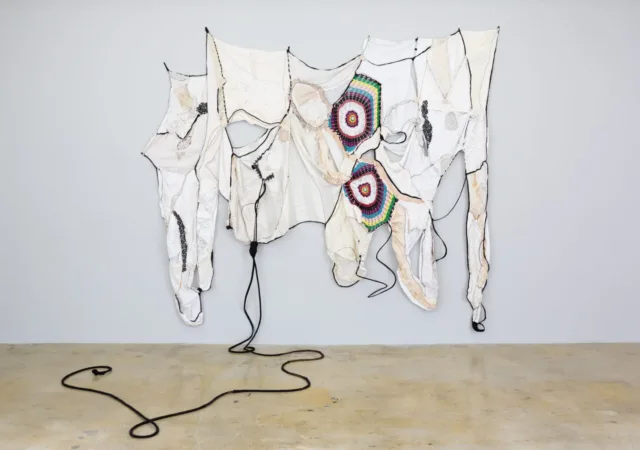
Sonia Gomes, Tantas Estorias, 2015; Fabric, stitching, and rope, 115 x 125 x 5 in.; 82 in.
“Abstractions are not the most popular form of art that is made in China, and women, although there are many in the art schools, are not actually the celebrated artists. There is a very tough ceiling to crack for woman in China. She creates…an emotional collage of urbanism that is constantly in flux and changing in Beijing.”
– Mera Rubell, collector
Hear Mera Rubell discuss Li Shurui’s art
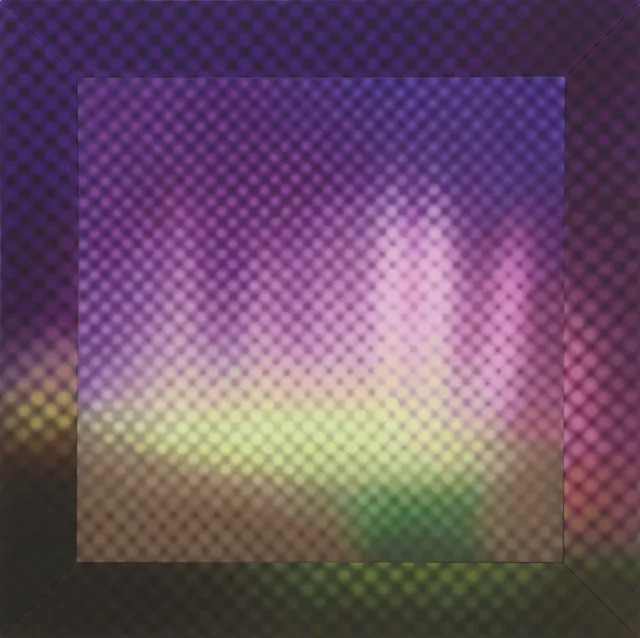
Li Shurui, I am not ready…, 2014; Acrylic on canvas, 98 x 98 in.
“Noting that canvas used for painting is a woven material, Auerbach created ‘weave paintings’ to amplify canvas’s structure. She values the similarity between the ancient technique of weaving and the structures of digital imagery.”
– Kathryn Wat, chief curator, NMWA
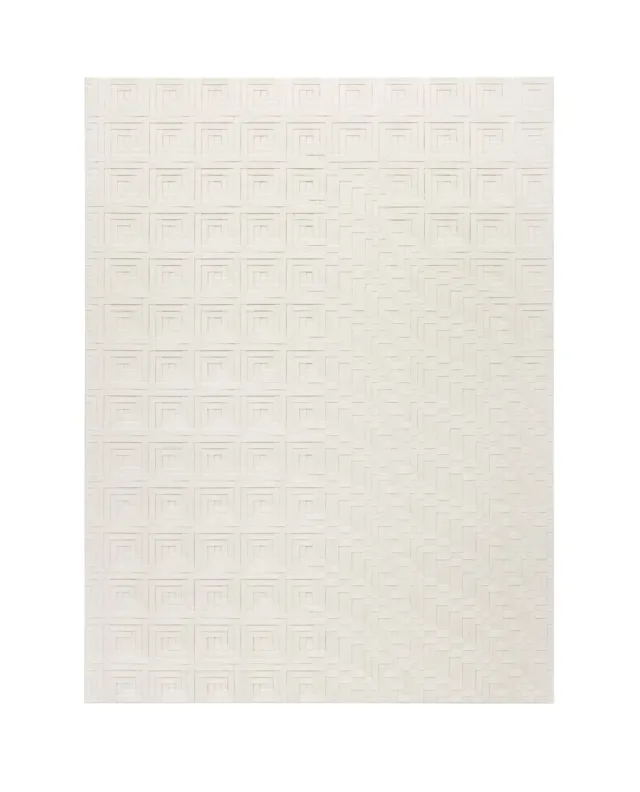
Tauba Auerbach, Slice II, 2012; Woven canvas on wooden stretcher, 60 x 45 in.
“Marten’s sculptures, formed through meticulous handcraft and inventive juxtapositions, are pictorial puzzles that invite the viewer to tease out new and multiple meanings.”
– Kathryn Wat, chief curator, NMWA
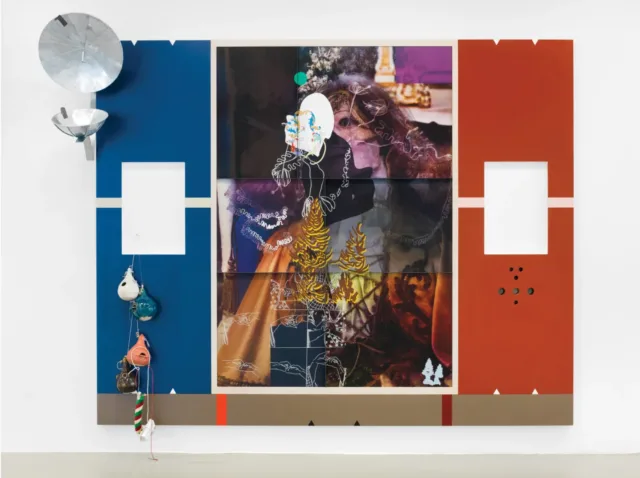
Helen Marten, Under blossom: B. uses frenzy, 2014; Screen printed suede, leather and waxed cotton, pressed Formica, ash, cherry, walnut, welded galvanized steel, glazed ceramic, strings, cast bronze and aluminum, and colored pencil on paper under resin, 105 ⅞ x 131 ½ x 3 in.
“Some of my early pieces talk about hidden places, about impenetrability, about desire. They also talk about the way of looking, about distance, about closeness, about detail.”
– Cristina Iglesias, artist
Hear Cristina Iglesias discuss her art

Cristina Iglesias, Untitled, L-4, 1986/1988; Iron and concrete, 86 x 35 ½ x 24 ½ in.
Image permissions for artworks were supplied by the artists and the Rubell Family Collection.
Audio clips provided by the artists and Don and Mera Rubell. Transcripts of the audio in this exhibition can be downloaded on the museum’s website.
Curators: Kathryn Wat & Virginia Treanor
Exhibition text editor: Elizabeth Lynch
Exhibition text adapted by: Deborah Gaston & Mara Kurlandsky
Project coordinator, audio: Adrienne Gayoso
Project coordinator, online exhibition: Mara Kurlandsky
© 2016 National Museum of Women in the Arts
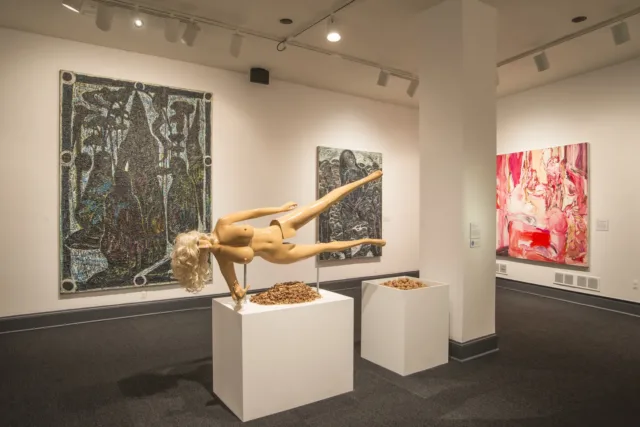
Installation view of <em>NO MAN’S LAND</em>, 2016; Photo by Lee Stalsworth
